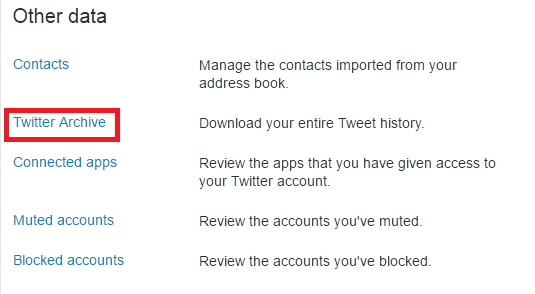

The picture above shows how to set it for Cloudflare, but it will be very similar in other providers. To do this we will only have to create a CNAME DNS record with the value of the subdomain ( tweets in this case) pointing to your GitHub domain that will be in the format GITHUB_ where GITHUB_HANDLE will be your handle/username in GitHub ( in my case).ĬNAME DNS record pointing to GitHub pages In this tutorial we will be using GitHub Pages to host our twitter archive, so since in my case I have the domain v managed by Cloudflare, I will create a subdomain called to point to the GitHub pages deployment. (Optional) Configuring a subdomain to point to our GitHub Pages deployment # Note: change the pathPrefix accordingly to the path you want. Įdit this file to change the first line 0 to module.exports (a simple replace) so the first part of the file will look as follows: module.
#Twitter archive data zip file
įollowing the instructions of Tweetback, open the zip file you downloaded from Twitter, and extract the data/tweets.js file from it into the database folder in your Tweetback repository folder.
#Twitter archive data install

Thanks to Zach Leatherman and its awesome project Tweetback, we can self host our own Twitter archive and keeping it up-to-date if necessary ( just like I have done with mine). An awesome project by Zach Leatherman to take ownership of your Twitter data in a public archive you can self-host (for example in GitHub). In this case it is where Tweetback come into action. why not just keeping it safe for the future?

Cover image generated by DALL-E 2 ("3D render of several tweets in a man hands on a dark blue background, digital art")ĭue to the "recent" acquisition of Twitter and all changes that came after that, lots of users started considering other alternatives such as Mastodon, Tumblr, Nostr and many others.īut what happens to the generated data over the years we have been making in this platform, what do we make with them? Discarding them? My thoughts on this are.


 0 kommentar(er)
0 kommentar(er)
